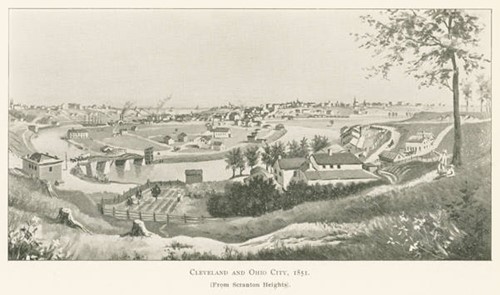Ohio City’s founding and growth are an important part of Cleveland’s immigration history and the story of the Ohio & Erie Canal.
Now one of Cleveland’s best known neighborhoods for restaurants and walkability, Ohio City is also one of Cleveland’s oldest areas. Founded independently from the City of Cleveland originally, Ohio City’s founding and growth are an important part of Cleveland’s immigration history and are part of the story of the Ohio & Erie Canal.
Early in Ohio City’s history, the city was populated with Irish and German immigrants who worked on the Ohio & Erie Canal. Although the city was founded as part of Brooklyn Township in 1805 and the city was laid out by 1819, the construction of the Ohio & Erie Canal had a considerable impact on Ohio City.
Irish and German immigrants moved to Ohio City as early as the mid-1820s with the hopes of finding employment. Ohio City’s Irish immigrants moved along the river, some in the area now known as Irishtown Bend. German immigrants settled around Lorain Avenue.
Many Ohio immigrants possessed aspirations of becoming farmers, but if they did not have enough money or resources to start farming, they searched for other employment. The construction of the Ohio & Erie Canal offered employment opportunities for many able-bodied Irish and German immigrants in Ohio City; however, the work was arduous and not well paid. The city had working-class housing for those who worked on the Ohio & Erie Canal. This housing continued to be occupied by working-class people after the canal was completed in 1832.

This is a bird’s eye view of Cleveland and Ohio City in 1851. Courtesy of Cleveland State University’s Cleveland Memory Project, Greater Cleveland Print Collection, 1896
By 1836, The Ohio & Erie Canal allowed shipping and trade to play a pivotal role in Ohio City’s local economy. It became a prosperous mercantile town with many people working as artisans, merchants, and skilled workers for local industries that depended on the Ohio & Erie Canal. That same year, nearly 2,000 schooners, steamboats, sloops, and brigs provided employment opportunities in Cleveland Harbor.
Due to the canal establishing Ohio City as a mercantile town, the first locomotive west of the Alleghenies was built at Ohio City’s Cuyahoga Steam Furnace in 1842. Cuyahoga Steam Furnace became the largest steam engine manufacturer by 1849.

Photo Credit: "Creative Commons West Side Market” by Erik Frost is licensed under CC BY 2.0
The cities of Cleveland and Ohio City were major commercial rivals from the 1830s. In fact, the rivalry between the two cities was so contentious that there was a one-day war on October 31, 1836 over the bridge that connected them. What came to be known as the Bridge War began out of Ohio City’s fear that the new bridge would cause a decline in goods coming and going from their city. The two cities merged into one in 1854, eliminating the rivalry.
The Ohio & Erie Canal sparked Ohio City’s local industry by allowing the quick and easy transport of goods, and setting it up for a prosperous future.
Today, Ohio City is close to the Ohio & Erie Canal Towpath Trail and home to the historic West Side Market. Learn more about the neighborhood at ohiocity.org/visit.
“Irish Ohioans.” Ohio History Central. Accessed September 22, 2022. https://ohiohistorycentral
.org/w/Irish_Ohioans.
Rotman, Michael. “Columbus Street Bridge,” Cleveland Historical. Accessed October
19, 2022, https://clevelandhistorical.org/items/show/74.
Supplementary Materials: Ohio & Erie Canal National Heritage Corridor Management Plan.
Vol. 2. Boston, MA: Icon Architecture, 2000.